- Home Page
- How To Fly
- Single Line Flying
Single Line Kite Flying
More Than Holding a String!
Oh yes! All sorts of unexpected things can happen when you're kite flying with a single liner. Have a browse down this page, and see if you can relate to any of the situations described.
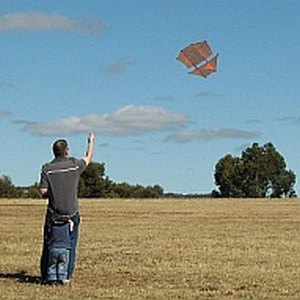 MBK 2-Skewer Dopero
MBK 2-Skewer DoperoIf you are flying for the first time, here's a chance to be more prepared than most people. I usually managed to go out flying several times a week, occasionally with other members of my family. Or I flew with the local kite club.
The best performers overall are our biggest kites, which are from the MBK Multi-Dowel Series. However, the 2-Skewer Series kites do very well in light wind. That's thanks to the amazing properties of bamboo!
Anyone can make the MBK designs, and they are super cheap! My best kite was usually the last one I had made, funnily enough.
OK, further down this page there's a whole list of kite-flying issues. We hope you find some help in there.
On this site, there's more kite-making info than you can poke a stick at :-)
Want to know the most convenient way of using it all?
The Big MBK E-book Bundle is a collection of downloads—printable PDF files which provide step-by-step instructions for many kites large and small.
Every kite in every MBK series.
Avoiding Obstacles
This might seem a strange topic at first, since you can't steer most single line kites. However, it happens all the time; kites get caught in trees! Not everyone has easy access to wide open spaces which are perfect for kite flying.
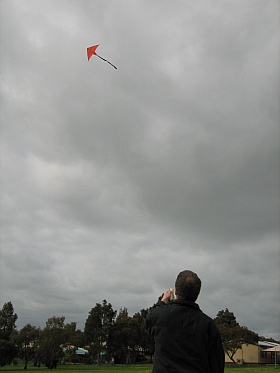 Trees lurking!
Trees lurking!Instead, many of us spend a lot of time in rather small parks since that's more convenient. The first thing I did when walking into a park or reserve was to test the wind direction and head for the area which would give the kite the most room.
You don't need a weather vane. Just toss up some dry leaves or a few blades of grass to get a rough idea of the wind direction. Once the kite is up, it will tell you exactly where the wind is coming from. You might find you have to move again, to give the kite the most room possible.
Despite having enough room in the general wind direction, you might find your kite flying far over to the left or right. Here's a few reasons, from most likely to least likely:
- A thermal is passing through.
- The wind strength has crept up and the kite has become less stable.
- The general wind direction has changed.
- Something has failed on the kite.
So, if the kite is heading over some trees with not a lot of height to spare, you need to act quickly! You can't assume that the kite will be fine and eventually return to center. It probably will, but then I've been caught out more than once! It's best to scoot across in the opposite direction, encouraging the kite to center itself and fly away from danger.
Another situation is where the kite is heading over some obstacles, but it is quite high. Even if it looped continuously, you might still have a quarter or half a minute before the line snags the obstacles below. In this case, it pays to just keep an eye on things. If anything starts to go wrong, you have time to wind in line so the kite ends up upwind of those kite eaters below!
For example, if the wind dies suddenly, it's easy. Just reel in line to keep the kite in the air and also to keep it away from the obstacles. If the wind picks up and the kite starts to loop, it's trickier. Winding in will make the looping worse, but you have no choice. Just get the thing out of trouble! Often, the situation improves as the kite gets lower, since the wind is usually slower near the ground. If you are brave, you can actually stop winding in for just a moment to see if the kite responds and climbs again.
Last Second Saves
Sounds dramatic hey? This kite flying situation usually occurs when the wind is really a bit too strong. Most of the time it's OK, but then a stronger gust comes along—there goes the kite, looping and diving. Oops, now it's heading directly for the ground, and fast! Don't panic. One of three things can happen, if you know what to do. The kite might
- recover by itself, in the slower air near the ground, or
- recover with a little help from the flyer, or
- hit the ground softly, with no damage done—with a little help from the flyer!
Those last two points involve the flyer, that's you, thrusting the reel or winder at the kite. You don't have time to let line out, you just shove the reel or winder at the kite, without letting go. You can take a step or two toward the kite too, which will make this action even more effective. The idea is to suddenly take all the tension out of the flying line. Kites just flutter and float if left to themselves for just half a second or so.
Bringing Down Quickly
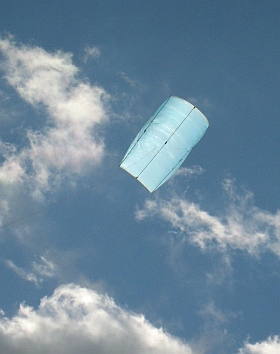 A huge sled can be a handful
A huge sled can be a handfulThis is sometimes necessary when weather conditions are not good, but you decide to go kite flying anyway. However, with the first few spots of rain, there are no excuses. The kite has to come down quick, or you are in danger of operating a very long lightning rod! In these circumstances, just throw the kite reel on the ground and take in line hand over hand as fast as you can.
Alternatively, if the kite is large and pulling strongly, it might make more sense to just walk quickly downwind. Bring down the line as you go, hand over hand, with the reel on the ground behind you. More likely, the line will have been secured to an anchor point, like a railing or sand bag.
The sled in the photo is such a kite! I have occasionally referred to it as The Horse ... because it pulls like one :-o
When the kite is on the ground, you can take your time winding all the line back onto the reel. Of course, weather isn't the only possible reason for needing to take action. Maybe the sun is about to go down and the mosquitoes are starting to bite with a vengeance!
High Kite Flying
Flying well above tree height is always a good idea in a park, provided the line is not actually near any trees. This goes for other obstacles as well, such as houses and other buildings. The air is much smoother up there, and your kite will behave much more predictably. About the only spot where this doesn't apply is on a wide smooth beach with the sea breeze coming in off the ocean!
Towing up to Faster Air
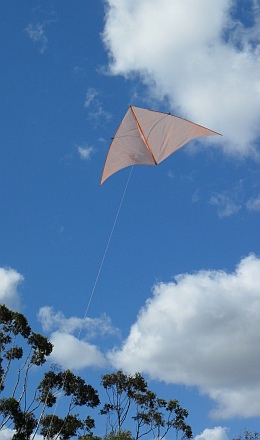 Just another 2KPH...
Just another 2KPH...Do you want to know a little kite flying trick that occasionally comes in handy in very light conditions?
This is worth trying if the breeze won't quite support the kite at ground level. You've tried time and time again to get the thing in the air, but it keeps on sadly sinking back to earth, after a promising hover or two. All you need is just one more knot or so of wind speed!
Because air gets slowed down near the ground, chances are that you will find that tiny extra bit of wind up higher. Let out plenty of line, at least 50 meters (150 feet) and drag the kite into the air. Pull in line just fast enough to keep it climbing until it reaches a good line angle.
If you have room, you could jog along instead, towing the kite on a fixed length of line. You might be surprised to find that the kite has no trouble staying up now!
Thermaling!
Oh yeah, make use of that rising air! Single line kites often get caught up in thermals, which float them up to very high line angles for a short while. However, it's fun to recognize what's happening and make more use of it. Some kite pilots have the opportunity to fly very high in places where air traffic regulations aren't as strict as they are here in Australia. Large delta kites are commonly used to explore thermals.
Even limited to 120 meters (400 feet) above ground, as I am, it's always a pleasure to occasionally bump into a thermal while kite flying. It's a buzz to let the string slip through my fingers just fast enough to climb the kite, almost vertically, until there is no more line to let out! There are some kite pilots who actively search the sky for thermals by maneuvering their kite. Single liners aren't directly steerable, but there are some ways of helping them drift this way or that. Pulling a bit of extra tension into the line will help a delta accelerate in the direction it happens to be pointing, for example.
Anchoring
It might seem a slightly boring thing to consider, but it's definitely a part of kite flying with single liners! It's sort of like leaving the kite on autopilot. I'll share a little trick of the trade with you. It's almost never necessary to actually tie a knot when anchoring a kite. All you have to do is find a roughly cylindrical object, for example a small tree branch, a pram handle or a railing of some sort. Then, put at least five wraps of line around the object and you should find there is no tendency to slip!
Just leave the reel or winder on the ground. Friction is the key, and the kite can pull as much as it likes, for as long as it likes. If you happen to find a pole that is very slippery, another two or three wraps will give you peace of mind.
It's hard to find cylindrical objects on a beach of course, unless you happen to dig something up. A weighty rock can be handy if you can find one nearby. You can put a few turns of line around it, to hold the kite. Another approach is to bring along a stake, which can be hammered into the sand, before you wrap the line around it. Actually, using a stake is sometimes the only option when you are kite flying in a large open area.
Another handy idea when kite flying at the beach is the sand anchor. This is just a bag or bags which can be filled with sand after you arrive. No winding here, you just lodge the reel under a bag that is heavy enough to do the job. It's a great option, since the bags weigh practically nothing and are easy to transport in your pocket or carry bag, depending on how big they need to be.
The kites in the photo below were anchored to a pier, while others were tied to vehicles parked on the sand.
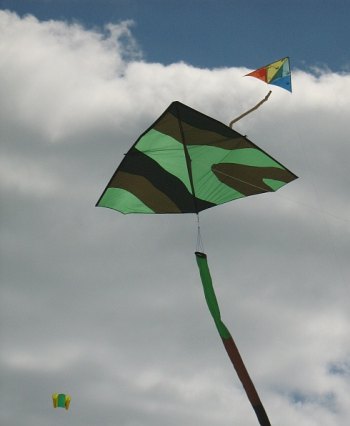 This kite drops lollies (candy) for the kids!
This kite drops lollies (candy) for the kids!
Lo-Tension Winding
This is a must unless the kite is hardly pulling at all due to weather or the size of the kite. To be convenient, this requires two people. One to pull down the kite, and the other to wind on line off the ground. This way, the line goes onto the reel with very little tension, and the reel will live to fly another day!
Don't try struggling to bring down a hard pulling kite while winding onto a plastic reel loop by loop. The reel might be totally crushed by the experience! ;-) I once got caught out this way, while kite flying with just an average-sized delta. This was despite trying to wind on with reduced tension. Even a small amount adds up with each loop.
If a second person is not available, it's still doable but not quite so convenient. You have to lay out line as you pull down the kite. But don't lay the line in one great heap, since that is a recipe for an enormous tangle! Just lay it out in a regular pattern. Alternatively, just walk out toward the kite, pulling it down as you go. After the kite is down, walk back to the reel and wind on all the line as you approach the kite a second time. Hey, it's good exercise! The older you get, the more you need it I'm finding.
As mentioned earlier, there's more kite-making on this site than you can poke a stick at :-)
Want to know the most convenient way of using it all?
The Big MBK E-book Bundle is a collection of downloads—printable PDF files which provide step-by-step instructions for many kites large and small.
Every kite in every MBK series.
